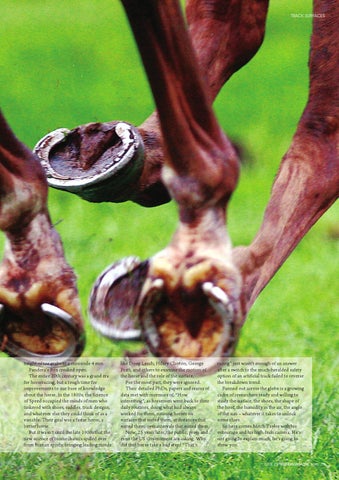SURFACES.qxd:Jerkins feature.qxd
24/2/09
21:24
Page 2
TRACK SURFACES
height of toe grabs to a miniscule 4 mm. Pandora’s Box creaked open. The entire 20th century was a grand era for horseracing, but a tough time for improvements to our base of knowledge about the horse. In the 1800s, the Science of Speed occupied the minds of men who tinkered with shoes, saddles, track designs, and whatever else they could think of as a variable. Their goal was a faster horse, a better horse. But it wasn’t until the late 1900s that the new science of biomechanics spilled over from human sports, bringing leading minds
like Doug Leach, Hilary Clayton, George Pratt, and others to examine the motion of the horse and the role of the surface. For the most part, they were ignored. Their detailed PhDs, papers and reams of data met with murmurs of, “How interesting”, as horsemen went back to their daily routines, doing what had always worked for them, running horses on surfaces that suited them, at distances that suited them, over intervals that suited them. Now, 25 years later, the public, press and even the US Government are asking: Why did that horse take a bad step? “That’s
racing” just wasn’t enough of an answer after a switch to the much-heralded safety option of an artificial track failed to reverse the breakdown trend. Fanned out across the globe is a growing cadre of researchers ready and willing to study the surface, the shoes, the shape of the hoof, the humidity in the air, the angle of the sun – whatever it takes to unlock some clues. So here comes Mitch Taylor with his entourage and his high-tech camera. He’s not going to explain much, he’s going to show you.
ISSUE 25 TRAINERMAGAZINE.com 31
